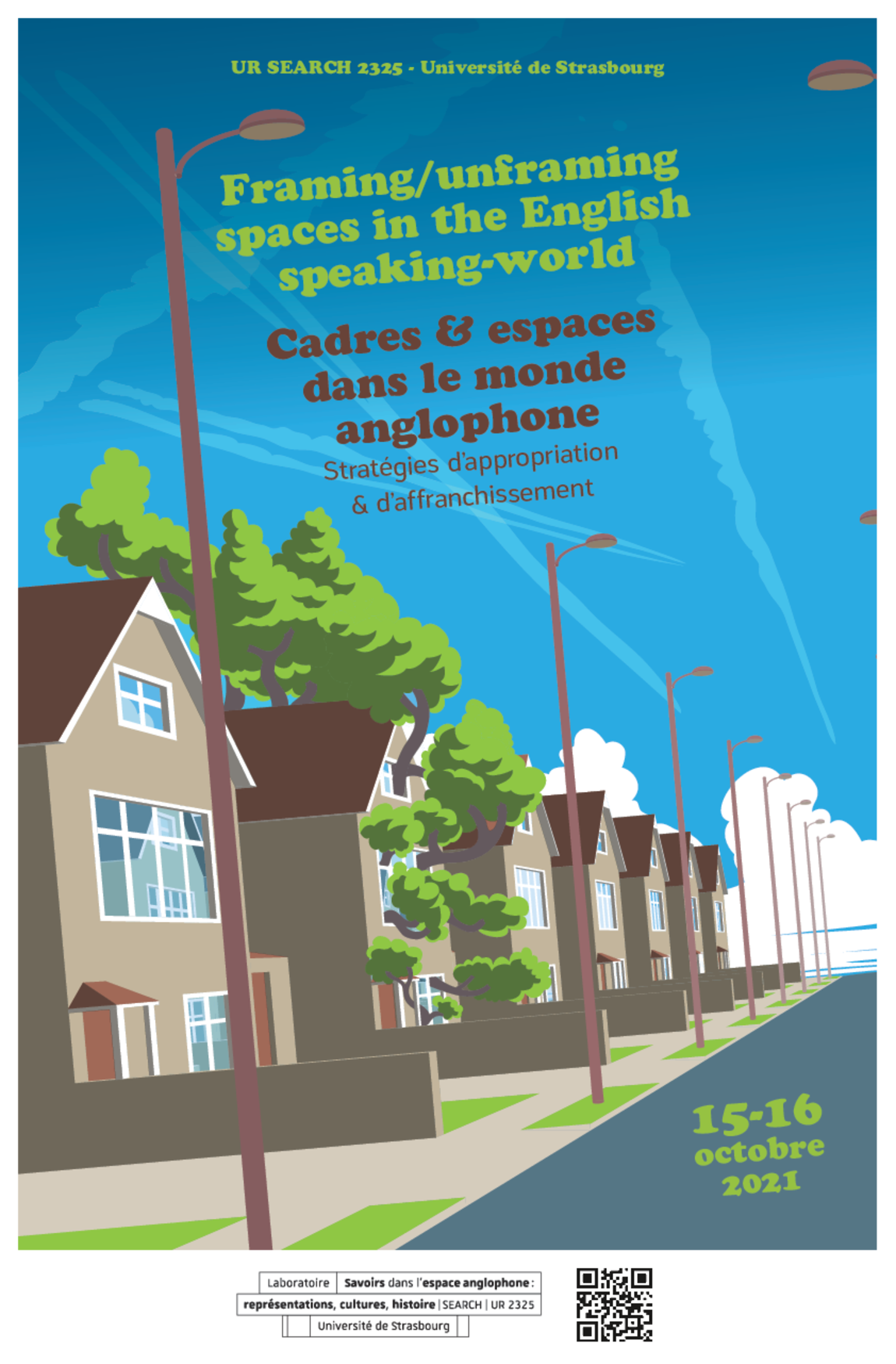Appel à communications
Après plusieurs colloques et publications sur la frontière, SEARCH (UR2325) poursuit son travail sur l’espace et sa délimitation en se penchant sur la question du cadre et de ses significations artistiques, littéraires, historiques, sociologiques ou géographiques.
Nous nous intéresserons d’une part aux opérations d’isolement et de circonscription d’un espace, comme dans l’art du paysage, et d’autre part à la « production de l’espace » (Lefebvre), sans pour autant nécessairement opposer ces deux dimensions l’une à l’autre. L’espace sera entendu au sens physique et géographique, mais aussi au sens social (les espaces sociaux et leurs règles) et au sens matériel (le tableau, la page, la scène, l’espace photographique ou cinématographique...). Le concept de cadre permettra d’envisager les modalités selon lesquelles on structure ou on déstructure l’espace, en accord avec les normes ou par leur transgression. Ces cadres peuvent être matériels, géographiques ou visuels, mais aussi sociaux, idéologiques ou épistémologiques. Ce sont ces cadres eux-mêmes, mais aussi la manière dont ils organisent notre expérience (Goffman), la façon dont on les crée ou on cherche à les abolir, les modalités selon lesquelles on les subit ou on les impose, qui seront au cœur de nos interrogations.
Délimiter
La notion de cadre implique une dualité intérieur/extérieur et un rapport d’inclusion, qui peut intégrer une dimension hiérarchique. Elle entraîne également la possibilité d’une transgression, ainsi qu’un certain nombre d’interactions entre le dedans et le dehors (Heller-Andrist). On pense à des opérations fondamentales de délimitation de l’espace comme l’Ordonnance du Nord-Ouest (1787) qui organisa la répartition mais aussi l’expansion du territoire des États-Unis, ou au quadrillage de Manhattan. Le cadrage géographique correspond ici déjà à un cadrage conceptuel et/ou idéologique, qui peut évoluer au fil du temps : on n’hésitera pas ainsi à montrer le changement des repères spatiaux lié par exemple à la conquête de l’Ouest, ou bien encore aux effets du dérèglement climatique. Pour ce qui est des arts et de la littérature, on pourra se pencher sur les cadres qui délimitent l’œuvre en circonscrivant son espace (cadre du tableau, espace de la page, etc.) ou encore interroger les tentatives de remise en cause du cadre, que ce soit par transgression, dissolution ou extension du cadre, de l’anti-art dadaïste aux Happenings, ou encore au Land art.
Concevoir
La délimitation d’un espace peut difficilement s’envisager sans une forme de conception de cet espace, qu’il s’agisse d’appréhender un espace pré-existant ou bien de concevoir un nouvel espace (Derrida), comme peut le dénoter le verbe anglais « to frame ». Cette conception peut résulter des rapports de pouvoir, et relever d’un mouvement d’appropriation ou de confiscation de l’espace, comme le montre le découpage de l’Afrique entre États coloniaux officialisé lors de la conférence de Berlin (1884-5), ainsi que les controverses sur la dimension genrée de l’aménagement urbain ou des cours de récréation. Cela vaut aussi pour les cadres historiographiques en tant qu’ils appliquent les régimes spatiaux d’une époque à des époques passées. La peinture de paysage ne délimite pas un espace tant qu’elle le construit. Cette construction constitue le paysage en objet en même temps qu’elle fait émerger un sujet qui regarde cet objet. Le cadre, davantage qu’une interface, devient ainsi la trace de cette opération de répartition. Pour Latour, la dichotomie même de nature et culture conduit à l’émergence de la nature en tant qu’objet que s’approprie et qu’exploite le sujet occidental. Ainsi, la notion de cadre peut servir de point de départ à une réflexion sur l’espace non pas en tant que donné, mais bien plutôt en tant qu’ensemble de relations. La littérature construit elle aussi des espaces par la représentation, tandis que les formes et genres littéraires, comme du reste les « règles de l’art », créent des rapports d’inclusion et d’exclusion.
Encastrements, superpositions, télescopages
Plusieurs phénomènes de cadrage peuvent se compléter, se superposer ou entrer en conflit. Dans le tableau, on pourra s’intéresser à l’image dans l’image, aux phénomènes de dédoublement, emboîtement, encastrement etc. (Stoichita), c’est-à-dire d’agencement des cadres les uns par rapport aux autres. On portera également une attention toute particulière aux phénomènes de transmédialité et d’intermédialité, qui sont propices au cadrage « hétéromédial » (Wolf & Bernahrt), qu’il s’agisse de l’ekphrasis ou de l’hypotypose en littérature, de la mise en relation du texte et de l’image dans l’art de l’emblème, des arts visuels et du performance art, de l’art et de l’intervention politique, ou de la transposition aux médias électroniques de l’espace du tableau ou de la page. Il peut s’agir aussi, grâce aux phénomènes de télescopage des cadres, de mieux comprendre comment ils fonctionnent, s’opposent, se renforcent, se transforment et permettent une circulation entre le dedans et le dehors.
Nous encourageons les propositions touchant à tous les pays de l’aire anglophone, quelle que soit l’époque abordée. Nous envisageons la publication d’une sélection de travaux issus du colloque.
Les propositions de communication pourront s’intéresser à :
- Cadres esthétiques
- Cadres et connaissance
- Cadres et pouvoir
- Production de l’espace
- Espaces sociaux et leurs règles
- Cadres de la représentation
- Normes et transgressions du cadre
- L’évolution des cadres
- Intermédialité/transmédialité
Les propositions de communications en anglais ou en français (300 mots) accompagnées d’une courte notice biographique sont à adresser à Pauline Collombier-Lakeman (collombier@unistra.fr) et Rémi Vuillemin (vuillem@unistra.fr) avant le 31 mai 2021.
Comité d’organisation : Sandrine Baudry, Pauline Collombier-Lakeman, Gwen Cressman, Yves Golder, Hélène Ibata, Monica Manolescu, Mélanie Meunier, Fanny Moghaddassi, Ghislain Potriquet, Rémi Vuillemin.
